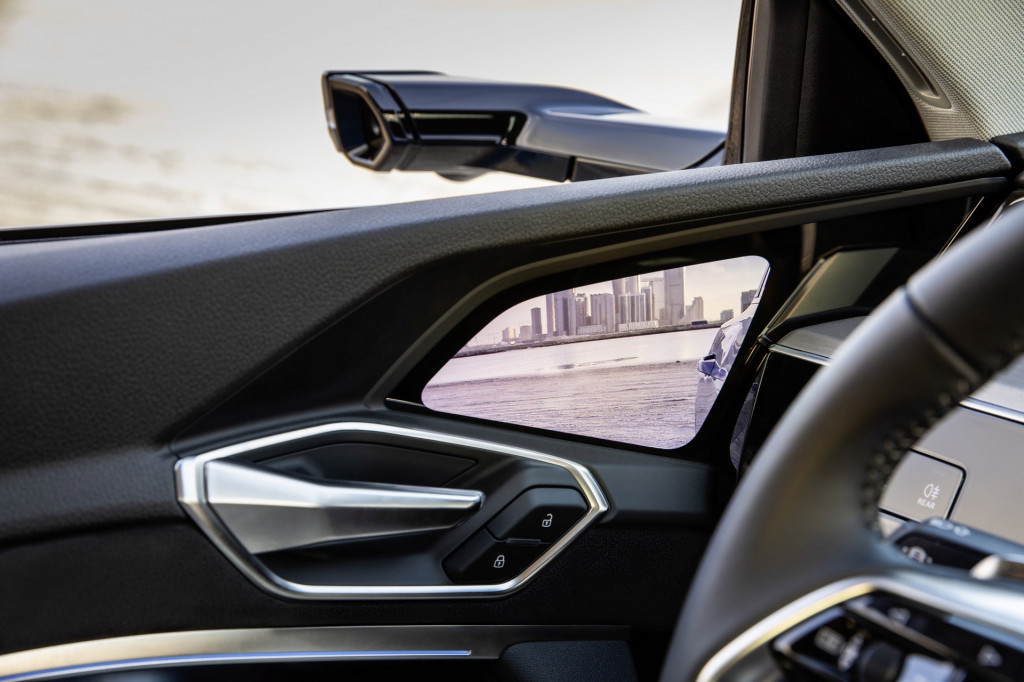Side-camera systems, replacing side mirrors, have been one of the de rigueur symbols of the future on auto-show concept cars for, well, pretty much this entire century so far.
While we’ve been eagerly anticipating the arrival of such systems for nearly as long—they’re not allowed by U.S. FMVSS standards, though now permitted in other world regions—some recent time with the system during our 2019 Audi e-tron first drive report was eye-opening.
According to Audi, the e-tron will be the first series-production vehicle in the world to offer a setup such as this, which uses small, aerodynamically streamlined side cameras.
DON’T MISS: Camera mirrors could add range to Audi e-tron electric SUV
The new Lexus ES, in some markets, will use a similar system, with its debut potentially sooner, but the Audi definitely wins for the slickest, smoothest integration of the system into the cabin design. On the forward upper sill of the front doors—where you otherwise might expect to see a small speaker—there’s a 7-inch, 1280x1080 OLED screen.
Audi puts the camera system on the e-tron for aerodynamics and efficiency (and less wind noise). It improves the coefficient of drag, from 0.28 in U.S. versions to 0.27 for a Euro-spec version with the system, which translates to up to 3 miles of range at (higher) highway speeds. It also reduces total vehicle width by 5.9 inches.

2019 Audi e-tron first drive - Abu Dhabi UAE, December 2018
Aiming the mirrors to fit your driving position is quite straightforward—certainly more so than the steering-wheel rollers you use to adjust mirrors on a Tesla Model 3. Here, you just tap an icon on the mirror touch screen, then ‘drag’ it in the direction you want displayed. Zooming in and out with the mirror are intuitive enough, too, in this world of smartphones and tablets. There are pre-programmed angles for highway driving, urban turns, and parking, but we didn’t find and use those in our drive (we were more focused on getting driving impressions of the entire vehicle).
CHECK OUT: Japan may beat U.S. to allowing camera-based side mirrors
But driving along in the mid-afternoon sun on desert highways near Abu Dhabi, we did notice some bothersome details. The screens got bleached-out in bright sunlight; and seeing our Euro-spec e-tron had no sunroof, it’s hard to imagine those screens playing well with the panoramic sunroof that U.S. versions will get.
At night we expected it to show off its image-processing strengths, but in the dark, passing in and out of overhead lighting on a freeway, we found the headlights of vehicles close behind to have splotchy halos that bleached out much of the screen, as it became more granular in an attempt to adapt to the dark scene like a camera out of ISO stops.

Euro-spec Audi e-tron with side-camera system
We also found it fatiguing to the eyes at lower city (and off-roading) speeds to be constantly looking back and forth between the screen and through actual glass that never had the same brightness—with the effect made worse by polarized sunglasses. During the day the screen was dimmer than the outside; at night it was brighter; and the whole idea of five screens in the vehicle (two for the mirrors, upper and lower center screens, and a gauge-cluster screen) felt excessive at night.
Those were nitpicks in the end. The thing that left my co-driver and me soundly in the “no, thanks” category for this technology was a depth-perception, field-of-focus factor that ends up missing. One of the issues, it seemed, was an inability to make a quick judgment of how fast a vehicle was coming up in the passing lane, or how soon we could cut back over to a slower lane. Your eyes have to linger longer on the screen than they would in a conventional mirror.
READ MORE: Tesla Takes The Lead On Dumping Door Mirrors For Video Cameras
We’ve noticed this same issue with some rearview-camera systems—Cadillac’s system that digitizes the rearview mirror, for example—but it seems a little more mission-critical for side mirrors. Human eyes are extraordinarily gifted at rapidly gauging approaching objects; just go tell someone with a baseball mitt to use a helmet-cam instead of his or her own eyes. Likewise, quickly craning your neck in city driving for the unexpected, to get a better view, just isn’t an option.

2019 Audi e-tron first drive - Abu Dhabi UAE, December 2018
The resounding “no, thank you” feelings we felt may have been fed by the idea that this isn’t an exotic vehicle. The e-tron has great sightlines over the hood, out the side windows, and even through the rear glass. While some curvy exotic cars might have some safety benefit from such a system it’s hard to see here—although such mirrors could become part of active-safety systems and are likely inevitable in an era of autonomous vehicle tech.
The verdict: As prepared as we were to pronounce this feature cool and scold slow-moving bureaucrats, we won’t. Americans aren’t missing out—not yet, at least. Given all the hype, this system is somewhat underwhelming, and even a little frustrating at times.













